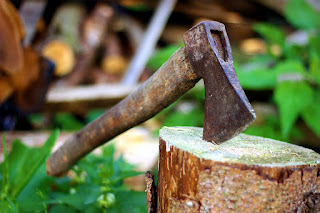ON KILLING A TREE
1. It takes much time to kill a tree
Not a simple jab of the knife Will do it, “- -What will the phrase, a simple jab of the knife’. mean? Why can’t a simple jab of the knife’ kill a tree? (2+4)
ANS. The phrase, ‘a simple jab of the knife’, means the attempt to kill a tree by mere stabbing it with a knife.
The poet says that an attempt to kill a tree only by stabbing it with a
knife cannot be successful. If a tree is struck hard with a knife,
it does not die. The tree can overcome such a blow. It has become strong
by absorbing the nutrients from the earth. Since birth, it has been
absorbing
sunlight, air and water. So a simple jabbing won’t kill it. A tree can
withstand a simple jab of the knife. The poet defines the difficult task
of cutting down trees by using such a phrase ironically.
2.“And out of its leprous hide sprouting leaves. “—What
does the expression ‘leprous hide’ refer to? What does ‘its leprous hide bear? (or What grows from it? What is the
significance of the expression? Bring out the irony suggested here.
[2+1+1+2]
ANS. The expression, ‘leprous hide’, refers to the bark of the tree
which looks like the skin of a leprosy patient. It is brown, dry and rough.Leaves grow from its
‘leprous hide’.
The poet here
personifies the tree by describing its bark as ‘leprous’. He uses a medical
term to personify the tree.
The expression is
ironical. Leprosy usually eats away the body and hampers normal growth.
But here, leprous hide is a source of growth. It bears the leaves that produce
food. It is not a symbol (image) of decay , but of growing life. This kind of image certainly makes the poem a
modern one.
3.How does a tree grow?
Or,
Describe in detail the growth of a tree, as I stated in the first stanza
of the poem, 0n Killing a Tree’.
ANS. In the first stanza
of the poem, ‘On Killing a Tree’, Gieve Patel describes the growth of a tree.
According to the poet, a tree grows slowly by consuming the nutrients from the
earth. The tree takes essential nutrients from the earth’s upper crust and
prepares its food. It also absorbs sunlight, air and water, the three elemental forces of nature, to produce food. This food reaches all parts of the tree as a result of which the tree grows. Thus, taking
in nutrients from the earth and the atmosphere , the
tree grows gradually. The poet describes the growth of a tree to suggest its
vivacity
4.So heck and chop
But this
alone won’t do it.—What does it refer to? Why won’t hacking and chopping
do ?
ANS.Here ‘it’ refers to killing a tree.
Hacking and chopping cannot destroy a tree completely. They may
inflict pain for the time being and affect the tree. But they won’t kill the
tree because its bleeding bark’ will heal itself. Then fresh twigs are sure to
come out from it and develop into small branches These fresh twigs that grow
near the ground will develop to
their former size if unchecked. The poet wants to mean that killing
a tree is a difficult task because ft also has life which has been
nourished for years.
5. “No,
The root is to be
pulled out—”—What does the word No
suggest? What are the methods used by man to completely destroy
a tree?
ANS. Here, the word ‘No’ suggests that hacking and chopping cannot
kill a tree. It can only inflict pain and cause the bark to bleed. But its
bleeding bark will heal itself and bear small green twigs close to the ground
with the help of its roots. This ‘no’ emphasises the idea that a tree
can’t be killed easily.
. Man realizes
that in order to completely kill a tree, the root has to be destroyed. The tree
has to be tied with a rope and pulled out entirely from the anchoring earth. As
a result, it is snapped (3f9f) totally from its support and the roots are
exposed to the scorching sunlight. Finally, the roots pass through various
processes of scorching, choking, browning, hardening, twisting and
withering. In
this manner, a tree is completely destroyed.
6. “The source, white and wet.
The most sensitive, hidden “—What does the word
source’ refer to here? How does the poet describe the root and its function?
[1+5]
ANS.The poet has
vividly described the root. His
scientific outlook and poetic imagination are mingled in his observation of the root. He considers the root to be the anchor of
the tree that stands firmly on the ground. The root is actually the strength of
the tree. It is the source of life. This life-supporting source is white and wet. It is white because
it has never been exposed to sunlight but is hidden inside the earth. It is wet
because it is full of water and other nutrients. The poet calls the root the
‘most sensitive’, thereby associating human quality to the tree.
7. Explain : “And then it is done”.
Ans. In his poem ‘On Killing a Tree’, Gieve Patel
gives a graphic description of the total destruction of a tree. Man realises that neither a simple jab of the knife nor hacking
and chopping can kill a tree. In order to kill a tree, it has to be uprooted. So the tree is roped, tied and pulled out. It is now cut off from the earth. Finally, in the presence of sun and air,
the roots pass through the processes of scor-ching, choking, browning, hardening, twisting,withering. In this way, the killing of a tree is complete. This expression highlights man’s satisfaction in destroying nature. Ironically it shows how man glorifies his cruelty
8.What is personification? How does the poet
personify the tree in the poem, ‘On Killing a Tree’?
Ans. Personification is a figure of
speech that gives human qualities to lifeless objects.In his poem ‘On Killing a Tree’, Gieve Patel looks upon the tree as a human being. Like a human being, the tree grows slowly. A tree consumes the earth and feeds upon its crust. It absorbs sunlight,
air and water for years and grows gradually The poet describes its bark as ‘leprous hide’. This is also a reference to the
affected skin of a leper The tree feels pain when it is hacked and chopped. It has ‘bleeding bark’ which heals naturally. The life supporting root of the tree is the most sensitive part because it
remains hidden inside the earth. All these images personify the tree.
8.What is a symbol? What does the tree
symbolise in the poem, ‘On Killing a Tree’?
Ans. A symbol is anything that represents or suggests an idea, image, belief, or action.In his poem, ‘On Killing a Tree’, Gieve Patel uses the tree as a powerful symbol of growth,
struggle and death. The tree symbolises nature, and its destruction shows man’s folly because in destroying nature, man destroys
himself. The tree is a generous helper.But, in turn, man kills the tree. A simple jab of the knife or mere act of hacking and chopping cannot kill a tree. It only inflicts pain. Its bleeding bark will
heal, bear leaves and grow to its former size. The green twigs and small boughs bring new hope. The root of the tree stands for firmness,security and strength. It is sensitive. The killing of
the tree by uprooting it and exposing it to the sunshows man’s insensitivity and cruelty that put human civilization under serious
threat.
9.How does the poet describe the killing of a
tree in the poem, ‘On Killing a Tree’?
Or, How can the tree be killed in ‘On Killing a
Tree’?
Or, How is the life-force of the tree
described in the poem ‘On Killing a Tree’?
Or, Write after Gieve Patel a note on the
power and: strength of a tree to withstand
man’s cruelty.ANS. The poet shows how a tree is tortured for complete destruction. Killing a tree is a difficult task. It takes much time and effort. Neither a simple jab of the knife nor hacking and chopping
can kill a tree. It is not so easy a task because the tree has grown slowly, consuming the earth and absorbing sunlight, air and water. It is firmly fixed with its roots anchored in the earth. After hacking
and chopping, new twigs sprout and grow to former size. So, in order to kill a tree it has to be uprooted, It has to be roped, tied and snapped out. It has to be pulled out entirely from the earth-cave.
After uprooting, the root has to be exposed to sunlight and air so that it scorches, chokes, browns, hardens, twists and finally withers. Thus man has to take up and more and more violent steps to complete the process of killing a tree.
10.Write a note on the poet's attitude to trees,
as revealed in the poem, ‘On Killing a Tree’.
OR,
Why does the poet describe the killing of a
tree in such graphic detail? }
Or, Consider the poem, ‘On Killing a Tree’,
as a telling commentary on one of the major .
environmental issues of the day.
Ans. The poet Gieve Patel has deep concern for
environment. In the poem, ‘On Killing a Tree’, he treats trees as living organisms He observes that man’s greed and selfishnesscause destruction of trees. So he raises his voice against reckless felling of trees. The images of violence that the poet uses in the poem show the poet’s genuine love for trees. Words and expressions such as ‘a simple jab of the knife’, ‘hack and chop’,‘pain’, ‘bleeding bark’, ‘most sensitive’ highlight the poet's heartfelt sympathy for trees. As a sensitive poet, Gieve Patel describes the killing of
a tree in such a vivid manner as to evoke our sympathy for trees.Thus the poem denounces man’s callousness towards the trees.



Good article
ReplyDeleteVerr good
ReplyDeleteVery useful
ReplyDeleteHmm
DeleteThankyou for help
ReplyDeleteThanks
ReplyDeleteHow is the tree finally killed
ReplyDeleteVery helpful 🙂🙂🙂
ReplyDeleteVery helpful🙂🙂🙂
ReplyDeletewhat is hidden meaning of poem on a killing tree
ReplyDelete